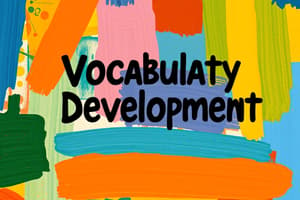Podcast
Questions and Answers
What is the primary purpose of previewing a text?
What is the primary purpose of previewing a text?
- To memorize every detail of the text
- To skim for an overview of the content (correct)
- To identify all vocabulary words
- To analyze the author's tone
Which strategy involves creating mental images to improve engagement?
Which strategy involves creating mental images to improve engagement?
- Making connections
- Questioning
- Annotating
- Visualizing (correct)
What do context clues help a reader infer?
What do context clues help a reader infer?
- The meaning of unknown words (correct)
- Supporting details
- Figurative language
- The author's main idea
What does analyzing the structure of a text typically involve?
What does analyzing the structure of a text typically involve?
Which of the following is NOT a type of figurative language?
Which of the following is NOT a type of figurative language?
What skill involves rewording text to ensure understanding?
What skill involves rewording text to ensure understanding?
What is essential for analyzing character development in a narrative?
What is essential for analyzing character development in a narrative?
Which of the following vocabulary strategies involves using visual diagrams?
Which of the following vocabulary strategies involves using visual diagrams?
Which term best describes the process of breaking a word into its individual sounds?
Which term best describes the process of breaking a word into its individual sounds?
What is the primary function of suffixes in word formation?
What is the primary function of suffixes in word formation?
Which strategy is effective for expanding vocabulary through active engagement?
Which strategy is effective for expanding vocabulary through active engagement?
What aspect of reading fluency involves expressing text in a natural rhythm and tone?
What aspect of reading fluency involves expressing text in a natural rhythm and tone?
Which type of context clue would be most helpful in understanding a new word that is immediately defined in the sentence?
Which type of context clue would be most helpful in understanding a new word that is immediately defined in the sentence?
Flashcards are hidden until you start studying
Study Notes
Reading Strategies
- Previewing Text: Skim headings, subheadings, and images to get an overview of content.
- Questioning: Encourage students to ask questions before, during, and after reading to enhance understanding.
- Visualizing: Create mental images of characters, settings, and events to improve engagement and recall.
- Making Connections: Relate the text to personal experiences, other texts, or world events to deepen comprehension.
- Annotating: Highlight or take notes on key ideas, unfamiliar words, and important details while reading.
Vocabulary Development
- Context Clues: Use surrounding text to infer the meaning of unknown words.
- Word Maps: Create visual diagrams illustrating a word's definition, synonyms, antonyms, and use in a sentence.
- Root Words and Affixes: Teach common prefixes, suffixes, and root words to build understanding of new vocabulary.
- Daily Vocabulary Practice: Introduce a word of the day and encourage usage in writing and speaking.
- Games and Activities: Utilize crossword puzzles, word searches, and flashcards to make learning vocabulary engaging.
Text Analysis
- Identifying Main Ideas: Focus on distinguishing the primary message from supporting details.
- Analyzing Structure: Examine how the text is organized (e.g., cause/effect, problem/solution).
- Understanding Tone and Purpose: Discuss the author’s tone (e.g., persuasive, informative) and the purpose of the writing.
- Character Analysis: Explore character traits, motivations, and development throughout a narrative.
- Theme Exploration: Identify and analyze overarching themes or messages in the text.
Figurative Language
- Similes and Metaphors: Understand comparisons using "like" or "as" (simile) and direct comparisons (metaphor).
- Personification: Recognize when human qualities are attributed to inanimate objects or animals.
- Hyperbole: Identify exaggerated statements that are not meant to be taken literally.
- Idioms: Learn common idiomatic expressions and their meanings beyond literal interpretations.
- Imagery: Analyze descriptive language that appeals to the senses, enhancing visualization and emotional connection.
Summarization Skills
- Identifying Key Points: Learn to extract main ideas and essential details from the text.
- Paraphrasing: Practice rewording text in one’s own words to ensure understanding.
- Using Graphic Organizers: Utilize tools like story maps or Venn diagrams to outline and organize thoughts.
- Constructing a Summary: Write concise summaries that include the main idea and supporting details.
- Peer Review: Engage in peer feedback sessions to refine summarization skills collaboratively.
Reading Strategies
- Previewing text helps identify the overall content through quick scanning of headings, subheadings, and images.
- Questioning promotes active engagement; students should formulate questions before, during, and after reading to improve comprehension.
- Visualizing aids retention by encouraging the creation of mental images of characters, settings, and events.
- Making connections strengthens understanding by associating texts with personal experiences, other literature, or current events.
- Annotating involves highlighting key ideas and unfamiliar terms, fostering active reading and better focus on details.
Vocabulary Development
- Context clues are essential for deducing the meanings of unknown words based on surrounding text.
- Word maps enhance vocabulary comprehension through visual representations of definitions, synonyms, antonyms, and example sentences.
- Teaching root words and affixes equips learners with the skills to decode unfamiliar vocabulary efficiently.
- Daily vocabulary practice, including introducing a "word of the day," encourages active use in writing and conversation.
- Engaging vocabulary activities, such as crossword puzzles and flashcards, make learning enjoyable and effective.
Text Analysis
- Identifying main ideas allows readers to distinguish key messages from supporting evidence and details.
- Analyzing structure involves examining narrative organization through methods such as cause/effect or problem/solution frameworks.
- Understanding tone and purpose helps readers grasp the writer's attitude and intention, such as whether the piece is persuasive or informational.
- Character analysis encourages exploration of traits, motivations, and development throughout the narrative arc.
- Theme exploration focuses on uncovering significant messages or underlying themes present in the text.
Figurative Language
- Similes and metaphors create comparisons, with similes using "like" or "as" and metaphors making direct comparisons.
- Personification attributes human traits to non-human elements, enhancing relatability in descriptions.
- Hyperbole is recognized as intentional exaggeration, often for emphasis or humor, not meant to be taken literally.
- Understanding idioms involves grasping expressions that hold meanings beyond their literal interpretations.
- Analyzing imagery involves recognizing descriptive language that appeals to the senses, enriching emotional responses and visualization.
Summarization Skills
- Identifying key points equips students to pinpoint main ideas and critical details from texts.
- Paraphrasing hones rewording skills, ensuring comprehension through restating information in one's own terms.
- Using graphic organizers, like story maps or Venn diagrams, assists in outlining and visually organizing thoughts and concepts.
- Constructing a summary requires writing concise versions of texts that encapsulate main ideas and significant supporting details.
- Peer review promotes collaborative feedback sessions to develop and refine summarization skills through group interaction.
Phonemic Awareness
- Words consist of individual sounds known as phonemes.
- Phonemic skills are critical for effective reading and include:
- Phoneme segmentation: Dividing words into distinct sounds.
- Phoneme blending: Merging sounds to create words.
- Phoneme substitution: Replacing a sound in a word to form a new word.
Affixes and Roots
- Roots: Fundamental parts of words that convey their essential meanings.
- Example: "struct" appears in words like "construct," "instruct," and "destruction."
- Affixes: Components added to a root to modify its meaning.
- Prefixes: Attached to the start of a root (e.g., "un-" in "unhappy").
- Suffixes: Affixed to the end of a root (e.g., "-ful" in "joyful").
- Knowledge of affixes aids in understanding unfamiliar words.
Vocabulary Development
- Techniques for expanding vocabulary include:
- Reading a variety of texts, from literature to nonfiction.
- Participating in word-based games and activities.
- Learning about synonyms, antonyms, and homophones.
- Practicing new vocabulary through writing and speaking reinforces retention.
Reading Fluency
- Reading fluency involves the smooth and accurate reading of text at a suitable pace.
- Key components of fluency:
- Accuracy: Correctly identifying words.
- Rate: A moderate reading speed that balances neither too fast nor too slow.
- Expression: Employing appropriate intonation and rhythm during reading.
- Fluency improvement strategies include:
- Repeated readings of familiar texts for practice.
- Partner reading or guided reading sessions.
Context Clues
- Context clues are hints from surrounding text that help deduce the meanings of unknown words.
- Various types of context clues include:
- Definition: The meaning of the word is provided in the sentence.
- Synonym: A similar word appears nearby to suggest meaning.
- Antonym: A contrasting word that provides insight into the word's meaning.
- Example: Specific examples given that aid in understanding.
- Utilizing context clues fosters critical thinking and enhances overall comprehension.
Studying That Suits You
Use AI to generate personalized quizzes and flashcards to suit your learning preferences.




